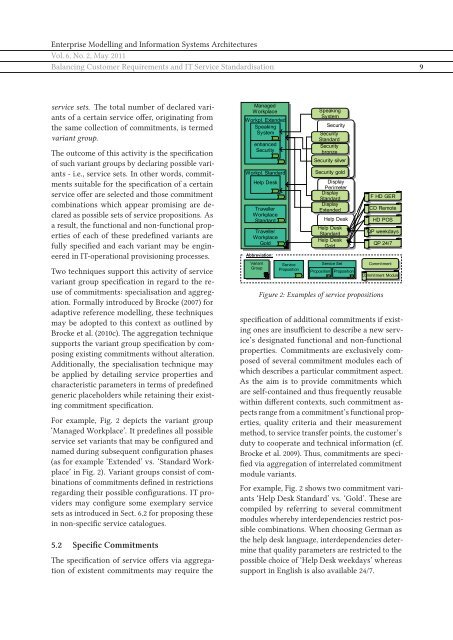Kundenorientierte Gestaltung und Vereinbarung standardisierter IT ...
Kundenorientierte Gestaltung und Vereinbarung standardisierter IT ...
Kundenorientierte Gestaltung und Vereinbarung standardisierter IT ...
Sie wollen auch ein ePaper? Erhöhen Sie die Reichweite Ihrer Titel.
YUMPU macht aus Druck-PDFs automatisch weboptimierte ePaper, die Google liebt.
Enterprise Modelling and Information Systems Architectures<br />
Vol. 6, No. 2, May 2011<br />
Balancing Customer Requirements and <strong>IT</strong> Service Standardisation 9<br />
service sets. The total number of declared variants<br />
of a certain service offer, originating from<br />
the same collection of commitments, is termed<br />
variant group.<br />
The outcome of this activity is the specification<br />
of such variant groups by declaring possible variants<br />
- i.e., service sets. In other words, commitments<br />
suitable for the specification of a certain<br />
service offer are selected and those commitment<br />
combinations which appear promising are declared<br />
as possible sets of service propositions. As<br />
a result, the functional and non-functional properties<br />
of each of these predefined variants are<br />
fully specified and each variant may be engineered<br />
in <strong>IT</strong>-operational provisioning processes.<br />
Two techniques support this activity of service<br />
variant group specification in regard to the reuse<br />
of commitments: specialisation and aggregation.<br />
Formally introduced by Brocke (2007) for<br />
adaptive reference modelling, these techniques<br />
may be adopted to this context as outlined by<br />
Brocke et al. (2010c). The aggregation technique<br />
supports the variant group specification by composing<br />
existing commitments without alteration.<br />
Additionally, the specialisation technique may<br />
be applied by detailing service properties and<br />
characteristic parameters in terms of predefined<br />
generic placeholders while retaining their existing<br />
commitment specification.<br />
For example, Fig. 2 depicts the variant group<br />
‘Managed Workplace’. It predefines all possible<br />
service set variants that may be configured and<br />
named during subsequent configuration phases<br />
(as for example ‘Extended’ vs. ‘Standard Workplace’<br />
in Fig. 2). Variant groups consist of combinations<br />
of commitments defined in restrictions<br />
regarding their possible configurations. <strong>IT</strong> providers<br />
may configure some exemplary service<br />
sets as introduced in Sect. 6.2 for proposing these<br />
in non-specific service catalogues.<br />
5.2 Specific Commitments<br />
The specification of service offers via aggregation<br />
of existent commitments may require the<br />
Managed<br />
Workplace<br />
Workpl. Extended<br />
Speaking<br />
System<br />
enhanced<br />
Security<br />
Workpl. Standard<br />
Help Desk<br />
Traveller<br />
Workplace<br />
Standard<br />
Traveller<br />
Workplace<br />
Gold<br />
Abbreviation:<br />
Variant<br />
Group<br />
Service<br />
Proposition<br />
Speaking<br />
System<br />
Security<br />
Security<br />
Standard<br />
Security<br />
bronze<br />
Security silver<br />
Security gold<br />
Display<br />
Display<br />
Perimeter<br />
Perimeter<br />
Display<br />
Standard<br />
Display<br />
Extended<br />
Help Desk<br />
Help Desk<br />
Standard<br />
Help Desk<br />
Gold<br />
Service Set<br />
Proposition Proposition<br />
F HD GER<br />
CD Remote<br />
HD POS<br />
QP weekdays<br />
QP 24/7<br />
Commitment<br />
Commitment Module<br />
Figure 2: Examples of service propositions<br />
specification of additional commitments if existing<br />
ones are insufficient to describe a new service’s<br />
designated functional and non-functional<br />
properties. Commitments are exclusively composed<br />
of several commitment modules each of<br />
which describes a particular commitment aspect.<br />
As the aim is to provide commitments which<br />
are self-contained and thus frequently reusable<br />
within different contexts, such commitment aspects<br />
range from a commitment’s functional properties,<br />
quality criteria and their measurement<br />
method, to service transfer points, the customer’s<br />
duty to cooperate and technical information (cf.<br />
Brocke et al. 2009). Thus, commitments are specified<br />
via aggregation of interrelated commitment<br />
module variants.<br />
For example, Fig. 2 shows two commitment variants<br />
‘Help Desk Standard’ vs. ‘Gold’. These are<br />
compiled by referring to several commitment<br />
modules whereby interdependencies restrict possible<br />
combinations. When choosing German as<br />
the help desk language, interdependencies determine<br />
that quality parameters are restricted to the<br />
possible choice of ‘Help Desk weekdays’ whereas<br />
support in English is also available 24/7.

















